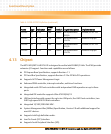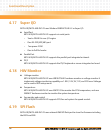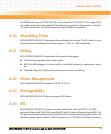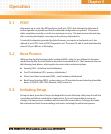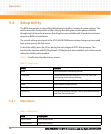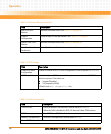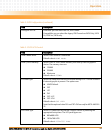
Chapter 5
MITX-430/MITX-440-DVI-2E Installation and Use Guide (6806800K37B)
73
Operation
5.1 POST
After power up or reset, the BIOS performs a self-test, POST, that attempts to determine if
further operation is possible and that the detected configuration is expected. This process
either completes normally or results in a warning or an error. The boot process does not stop
after a warning but displays a message on the primary display device.
To view all checkpoints generated by Aptio firmware, you require a checkpoint card, also
referred to as a POST Card or POST Diagnostic Card. These are LPC add-in cards that show the
value of I/O port 80h on a LED display.
5.2 Boot Process
While performing the functions of the traditional BIOS, Aptio 4.x core follows the firmware
model described by the Intel Platform Innovation Framework for EFI. The framework refers to
the following boot phases, which applies to various status code descriptions:
z Security (SEC) - initial low-level initialization
z Pre-EFI Initialization (PEI) - memory initialization1
z Driver Execution Environment (DXE) - main hardware initialization2
z Boot Device Selection (BDS) - system setup, pre-OS user interface and selecting a bootable
device (CD/DVD, HDD, USB, Network, Shell, and so on)
5.3 Initiating Setup
During the boot, press the F2 key on the keyboard to launch the setup utility once the self-test
is complete and before searching for a boot device. If you exit setup without saving any
changes, the boot process continues with the search for a boot device. If changes are made,
the motherboard loads the new settings and resets, restarting the entire boot process.






